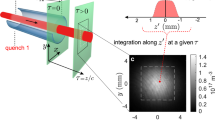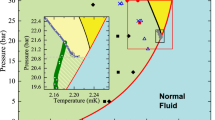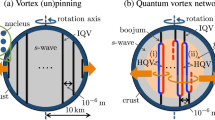Abstract
TOPOLOGICAL defects in the geometry of space–time (such as cosmic strings) may have played an important role in the evolution of the early Universe, by supplying initial density fluctuations which seeded the clusters of galaxies that we see today1. The formation of cosmic strings during a symmetry-breaking phase transition shortly after the Big Bang is analogous to vortex creation in liquid helium following a rapid transition into the superfluid state; the underlying physics of this cosmological defect-forming process (known as the Kibble mechanism1) should therefore be accessible to experimental study. Superfluid vortices have been observed in 4He following rapid quenching to the superfluid state2, lending qualitative support to Kibble's contention that topological defects are generated by such phase transitions. Here we quantify this process by using an exothermic neutron-induced nuclear reaction to heat small volumes of super-fluid 3He above the superfluid transition temperature, and then measuring the deficit in energy released as these regions of normal liquid pass back into the superfluid state. By ascribing this deficit to the formation of a tangle of vortices, we are able to infer the resulting vortex density; we find that this agrees very well with the predictions of Zurek's modification3 of the original Kibble mechanism1.
This is a preview of subscription content, access via your institution
Access options
Subscribe to this journal
Receive 51 print issues and online access
$199.00 per year
only $3.90 per issue
Buy this article
- Purchase on Springer Link
- Instant access to full article PDF
Prices may be subject to local taxes which are calculated during checkout
Similar content being viewed by others
References
Kibble, T. W. B. J. Phys. A9, 1387–1398 (1976).
Hendry, P. C., Lawson, N. S., Lee, R. A. M., McClintock, P. V. E. & Willians, C. H. D. Nature 368, 315–317 (1994).
Zurek, W. H. Nature 317, 505–508 (1985).
Volovik, G. E. Exotic Properties of Superfluid3He (World Scientific, Singapore, 1992).
Bradley, D. I. et al. Phys. Rev. Lett. 75, 1887–1891 (1995).
Chuang, I., Durrer, R., Turok, N. & Yurke, B. Science 251, 1336–1342 (1991).
Ruutu, V. M. H. et al. Nature 382, 334–336 (1986).
Fisher, S. N., Guénault, A. M., Kennedy, C. J. & Pickett, G. R. Phys. Rev. Lett. 69, 1073–1076 (1992).
Adams, J. S. et al. Phys. Lett. B341, 431–434 (1995).
Author information
Authors and Affiliations
Rights and permissions
About this article
Cite this article
Bäuerle, C., Bunkov, Y., Fisher, S. et al. Laboratory simulation of cosmic string formation in the early Universe using superfluid 3He. Nature 382, 332–334 (1996). https://doi.org/10.1038/382332a0
Received:
Accepted:
Issue Date:
DOI: https://doi.org/10.1038/382332a0
This article is cited by
-
Supercooling of the A phase of 3He
Nature Communications (2023)
-
Observing flow of He II with unsupervised machine learning
Scientific Reports (2022)
-
Kink-antikink scattering in a quantum vacuum
Journal of High Energy Physics (2022)
-
Quantum nucleation of topological solitons
Journal of High Energy Physics (2022)
-
Holographic topological defects and local gauge symmetry: clusters of strongly coupled equal-sign vortices
Journal of High Energy Physics (2021)
Comments
By submitting a comment you agree to abide by our Terms and Community Guidelines. If you find something abusive or that does not comply with our terms or guidelines please flag it as inappropriate.



